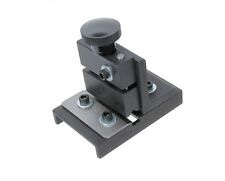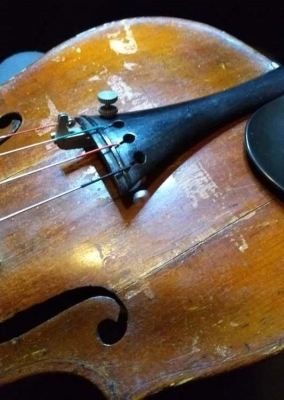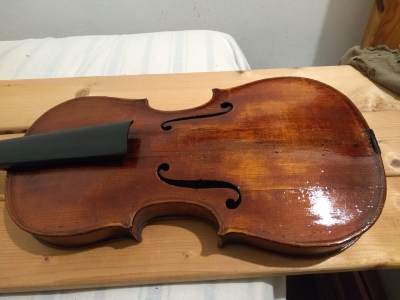Welcome to our forum. A Message To Our New and Prospective Members . Check out our Forum Rules. Lets keep this forum an enjoyable place to visit.
Currently working on errors from the latest (SimplePress) forum update. Many issues have been resoled and others are being worked on. Thank you for your patience.
 Topic RSS
Topic RSS



 (0 votes)
(0 votes) Regulars


There's no easy or humorous way to admit to this, so I'll just fess up:
I put electrical tape on my top plate.
I've now taken strips of varnish off my violin, revealing the ground layer underneath, and I have questions.
(1) Can I locally protect the wood local to the damage with a coat of something (oil varnish?) until I can get the instrument refinished, or is it better left as an 'open wound'?
(2) The varnish is thin and hard; is this likely to be spirit varnish, or something used by luthiers long ago? The material reminds me of rosin in its physical character.
(3) Am I now on some kind of register for confessing to this?
For what it's worth, my well-rehearsed clamping of the glued cracks in the plate failed once the nice lubricating layer of liquid leather went in. I panicked, and grabbed the tape. No, you couldn't make it up, and I have a stripy fiddle to prove it. Be nice to me, and I'll show the photos.
Humbly,
Peter
Peter
"It is vain to do with more that which can be done with less" - William of Ockham
"A crown is merely a hat that lets the rain in" - Frederick the Great
Regulars
 Offline
Offline

Shellac will adhere to any finish. Oil, not so much. Steve Duf (the author of several threads here when he was active) was a big fan of the French Polish method, and he does a lot of beautiful work with old violins. A bonus would be that the alcohol, which is the carrier of the new shellac, tends to remelt the old finish so the crackling goes away.
I would attempt to apply water color pigments over the areas of bare wood (wear marks from bridge, fine tuner rash, and edge blemishes) before applying finish. Caked on rosin (and likely electrical tape adhesive) is generally removed with naphtha (lighter fluid).
French Polish is not difficult, but you may want to view a few You Tube videos before flying solo.
Success is the progressive realisation of a worthy ideal. —Earl Nightingale.
Regulars


Thanks, @Irv; shellacing the plate sounds like a simple solution. I'll take your recommendation of YT research, and find a method which allows me to re-colour the stripped areas, and refinish the entire plate to restore the fiddle. The back and ribs have been refinished at some time, because their colour and figuring are far clearer. The plates are fully carved, one-piece items.
There's no electrical tape adhesive residue: it all came away when I peeled the stuff off on Sunday morning, taking the varnish with it. It felt horrible. On reflection, the tape might have left its glue behind if I'd have warmed it, and I could've removed the adhesive with solvent subsequently. We learn by doing, and this was a tough lesson. It would have been more sensible to have washed the hide glue out of the cracks, revised the clamping and started over.
I can practice shellac work and French polishing on other items before I commit to the fiddle. Thanks once again for your counsel.
Blessings,
Peter
Peter
"It is vain to do with more that which can be done with less" - William of Ockham
"A crown is merely a hat that lets the rain in" - Frederick the Great
Advanced member
 Offline
OfflinePeter, I too have made a mistake with the varnish on my violin, Fiddlerman recommended a varnish marker or pen to touch it up. I don’t know if he will recommend that ever to anyone else based on what he saw when I got carried away with the two markers. Trust me, it was beyond bad. But you could ask. I did purchase it from Fiddlershop which is why he recommended the two varnish colors, your situation could be different.
Regulars


Thanks, @x Coach, but it will need more than a pen to touch-up this mess.
Here I can reveal the full horror:
Besides the strips denuded by the tape, there are a myriad of spots where time has taken lumps out of the varnish, and a full refinish is probably best. I like @Irv's suggestion of shellac-based French polish, as this is quick to effect a finish and won't leave the fiddle unusable for days (or weeks...). Those cracks have been glued and cleated, and the top plate is now quite tight and the violin sounds handsome. I was so peeved with myself about the tape that I quite forgot to put the repair label inside.
Fiddlerman's varnish pens are probably good for the odd ding or scratch, but I have so much more ground to cover (literally). I originally wanted to leave the wounds of time as a glorious patina, but that tape...!
Thanks,
Peter
Peter
"It is vain to do with more that which can be done with less" - William of Ockham
"A crown is merely a hat that lets the rain in" - Frederick the Great
Regulars


Hi @Fiddlerman,
Character is something the fiddle has lots of. A couple of the middle-bout corners have gone, and it looks generally battle-scarred. It's been starved of humidity, hence the need to repair cracks in the top plate. It also has a crack in the pegbox into the A peg, and that will need to be closely watched. I've made one of @Irv's Mk.III humidifiers, and all should now be well.
I'd still like to put a slick top-coat of shellac on it, just to mitigate wear from the daily wipe-down. This fiddle is possibly a very old lady (I gently cleaned the label, and if it is authentic she was one of Cuypers' early works in 1746), and she deserves some respect in her dotage.
Thanks,
Peter
Peter
"It is vain to do with more that which can be done with less" - William of Ockham
"A crown is merely a hat that lets the rain in" - Frederick the Great
Regulars
 Offline
Offline

Hello @Peter and others. I have found that glue alone is unsuccessful in repairing peg head cracks. Fortunately, small diameter carbon fiber rod is inexpensive since it is used extensively in the remote control vehicle hobby. I have been very happy with using that material to reinforce broken peg box cracks. I would have included some in the care package had I known of the issue.
I am glad to know that the Mark III humidifier technology has make it “across the pond.”
Success is the progressive realisation of a worthy ideal. —Earl Nightingale.
Regulars


Thanks @Irv,
I've seen the way forward on the pegbox repair: drill out the area and fit a hardwood sleeve (or a piece of carbon fibre tube, courtesy of my youngest son). I'll be using epoxy on this repair, because the repair should last for as long as the original in this case (70 to 270 years). I'll thus be buying a tapered reamer (they all seem to be specified as 30:1) and wondered if you have recommendations on a trusted manufacturer, or would something from around 115 degrees east be good enough? I will attempt to measure the taper of my pegs, in case they're a little more bespoke than expected.
Peter
Peter
"It is vain to do with more that which can be done with less" - William of Ockham
"A crown is merely a hat that lets the rain in" - Frederick the Great
Regulars
 Offline
Offline

@Peter and others. I have had good luck with the Chinese import reamers specifically made for the violin task at hand (wood workshop reamers will not work for the task). However, you should also look at getting a peg shaver. I have only had joy with one style.  It is easy to adjust the angle of this shaver to match the slope of the reamer.
It is easy to adjust the angle of this shaver to match the slope of the reamer.
New ebony pegs are inexpensive. You may also want to consider planetary gear pegs such as Knilling or Wittner. I find the Knilling easier for me to install.
Success is the progressive realisation of a worthy ideal. —Earl Nightingale.
Regulars


Hi @Mouse,
The coating will be thin, and clear. I'm hoping it will not only protect the fiddle's top plate from me dusting off the rosin each evening, but present the instrument's past, warts 'n' all, highlighting the purfling and the wood grain. French polish is a thin, hard finish and should not add anything acoustically, but I'm quite prepared to be surprised and contrite.
Hi @Irv,
I quite like the idea of epicyclic tuners; they mean one can have geared tuning without the awkward fine-tuners at the tailpiece (the old fiddle has just one). I've become fairly adept at creaking the pegs to bring the strings up to tune, and our domestic circumstances don't allow for too much investment in music so geared pegs will keep for a future upgrade. I'm kind of lucky in that the old fiddle was so cheap, and the other (solid) fiddle was made from whatever I could find laying around the household. I only bought the strings. The old fiddle came with a small collection of new bridges, and I now prefer my short, homemade bow to the full size bow which came with the old 'un.
Peter
"It is vain to do with more that which can be done with less" - William of Ockham
"A crown is merely a hat that lets the rain in" - Frederick the Great
Regulars


The French polish went on today, after a little judicious surface prep with some fine steel wool. I used the wool to feather-out the tape scars; patina is one thing, evidence of stupidity (outside of this thread) is quite another.
The photo above is of the freshly-applied second coat of polish; I'll review it tomorrow evening, and decide then whether it needs more layers or if I should just re-string and enjoy.
Peter
"It is vain to do with more that which can be done with less" - William of Ockham
"A crown is merely a hat that lets the rain in" - Frederick the Great
Regulars
 Offline
Offline

@Peter and others. Looks good. You might want to consider the use of a metal polish to even out finish and add some shine to it (if necessary, hard to tell from photo). I have used semi chrome and wenol with about equal success. I would start in an unexposed area (like under the tail piece) before I went great guns about it.
Success is the progressive realisation of a worthy ideal. —Earl Nightingale.
Regulars
 Offline
Offline






Regulars


Thank you all for your advice and kind words.
To close out the thread:
French polish (two applications) appears not to materially alter the tone, timbre or general sound of the violin, but my ear is more attuned to recovering faint 700 Hz telegraphy signals than appreciating a fiddle's nuanced output while tucked under my chin; I'm still very green here.
The finish is glossy, hard, pale yellow and transmits the beauty of the underlying wood. I am comfortable that it will survive the daily wipe-down after practice. The margins between the bare wood and the original varnish are perceptibly stepped, but this is not unduly obtrusive. It'd look out-of-place in an orchestral situation, but cool in the folk club.
On a personal note, I still feel very intimidated by the violin. I restrung it, tuned up and grabbed my short home-made bow (it was rosined ready and at hand), and gently stroked the strings: I played a little while, but bowed slowly, hair on edge. Just one verse of Vaughan Williams' 'Linden Lea', and then a wipe-down and back in the case. Then I picked up the homebrew electric and played / busked for a good half hour.
Peter
"It is vain to do with more that which can be done with less" - William of Ockham
"A crown is merely a hat that lets the rain in" - Frederick the Great
Regulars
 Offline
Offline

@Peter and others. I must advance an inquiry regarding the use of a “silent” electric instrument for outdoor busking. The silent aspect must diminish revenue unless some sort of electronic enhancement is employed. My amp of choice would be a Yamaha THR5. But since my operational definition of an engineer is a person that can do something for a $1 that would take other people $10, I am interested in how you do this.
Success is the progressive realisation of a worthy ideal. —Earl Nightingale.
Regulars


@Irv,
Two issues:
- Busking was a poor choice of verb; I meant jamming, but there's something wrong in my English. I'm a stickler for punctuation and grammar, but I have a perverted streak in semantics.
- My amplifiers have always been home-made; cost is a powerful driver of this, but also the desire to make all and only what I need. The electric has a built-in headphone amplifier, and I have a terminated / attenuated DI cable for connecting to my performance amplifier (intended for guitar, but capable of very clean throughput) or my smartphone for intonation monitoring. It's also capable of some heavy crunch, with an even-harmonic distortion circuit quite at odds with the usual semiconductor flat-topping. I have a smaller amplifier built into a 5" square by 3" tall wooden drawer (it still lives in the chest of drawers from whence it was taken) which would be great for true busking or other ad hoc performance, since it is battery-powered.
Apologies to all here; I've bent the topic a good three semitones, at the risk of falling off the fretboard.
Peter
"It is vain to do with more that which can be done with less" - William of Ockham
"A crown is merely a hat that lets the rain in" - Frederick the Great
1 Guest(s)


 Log In
Log In Register
Register
























